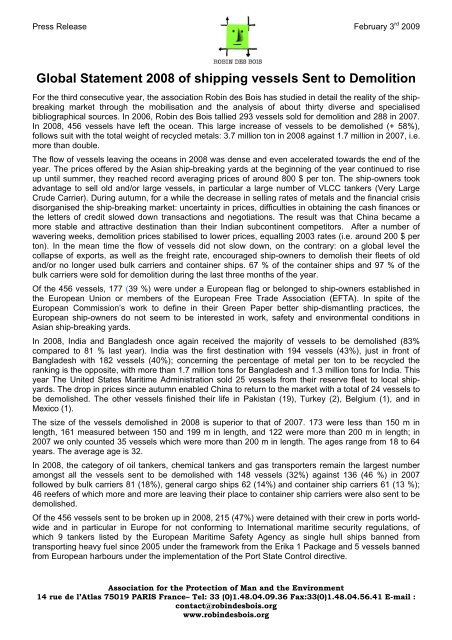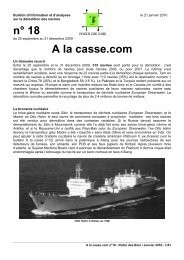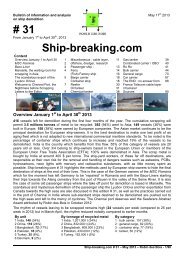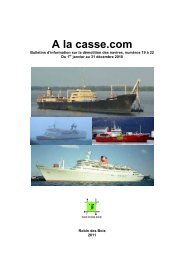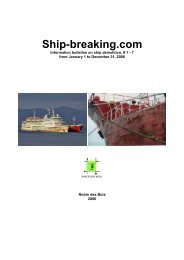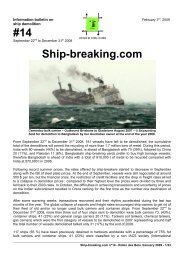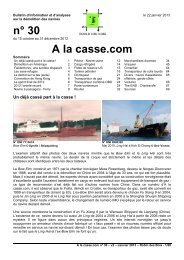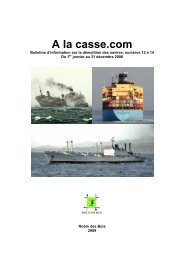Ship-breaking.com. Special issue, global statement ... - Robin des Bois
Ship-breaking.com. Special issue, global statement ... - Robin des Bois
Ship-breaking.com. Special issue, global statement ... - Robin des Bois
You also want an ePaper? Increase the reach of your titles
YUMPU automatically turns print PDFs into web optimized ePapers that Google loves.
Press Release February 3 rd 2009<br />
Global Statement 2008 of shipping vessels Sent to Demolition<br />
For the third consecutive year, the association <strong>Robin</strong> <strong>des</strong> <strong>Bois</strong> has studied in detail the reality of the ship<strong>breaking</strong><br />
market through the mobilisation and the analysis of about thirty diverse and specialised<br />
bibliographical sources. In 2006, <strong>Robin</strong> <strong>des</strong> <strong>Bois</strong> tallied 293 vessels sold for demolition and 288 in 2007.<br />
In 2008, 456 vessels have left the ocean. This large increase of vessels to be demolished (+ 58%),<br />
follows suit with the total weight of recycled metals: 3.7 million ton in 2008 against 1.7 million in 2007, i.e.<br />
more than double.<br />
The flow of vessels leaving the oceans in 2008 was dense and even accelerated towards the end of the<br />
year. The prices offered by the Asian ship-<strong>breaking</strong> yards at the beginning of the year continued to rise<br />
up until summer, they reached record averaging prices of around 800 $ per ton. The ship-owners took<br />
advantage to sell old and/or large vessels, in particular a large number of VLCC tankers (Very Large<br />
Crude Carrier). During autumn, for a while the decrease in selling rates of metals and the financial crisis<br />
disorganised the ship-<strong>breaking</strong> market: uncertainty in prices, difficulties in obtaining the cash finances or<br />
the letters of credit slowed down transactions and negotiations. The result was that China became a<br />
more stable and attractive <strong>des</strong>tination than their Indian subcontinent <strong>com</strong>petitors. After a number of<br />
wavering weeks, demolition prices stabilised to lower prices, equalling 2003 rates (i.e. around 200 $ per<br />
ton). In the mean time the flow of vessels did not slow down, on the contrary: on a <strong>global</strong> level the<br />
collapse of exports, as well as the freight rate, encouraged ship-owners to demolish their fleets of old<br />
and/or no longer used bulk carriers and container ships. 67 % of the container ships and 97 % of the<br />
bulk carriers were sold for demolition during the last three months of the year.<br />
Of the 456 vessels, 177 (39 %) were under a European flag or belonged to ship-owners established in<br />
the European Union or members of the European Free Trade Association (EFTA). In spite of the<br />
European Commission’s work to define in their Green Paper better ship-dismantling practices, the<br />
European ship-owners do not seem to be interested in work, safety and environmental conditions in<br />
Asian ship-<strong>breaking</strong> yards.<br />
In 2008, India and Bangla<strong>des</strong>h once again received the majority of vessels to be demolished (83%<br />
<strong>com</strong>pared to 81 % last year). India was the first <strong>des</strong>tination with 194 vessels (43%), just in front of<br />
Bangla<strong>des</strong>h with 182 vessels (40%); concerning the percentage of metal per ton to be recycled the<br />
ranking is the opposite, with more than 1.7 million tons for Bangla<strong>des</strong>h and 1.3 million tons for India. This<br />
year The United States Maritime Administration sold 25 vessels from their reserve fleet to local shipyards.<br />
The drop in prices since autumn enabled China to return to the market with a total of 24 vessels to<br />
be demolished. The other vessels finished their life in Pakistan (19), Turkey (2), Belgium (1), and in<br />
Mexico (1).<br />
The size of the vessels demolished in 2008 is superior to that of 2007. 173 were less than 150 m in<br />
length, 161 measured between 150 and 199 m in length, and 122 were more than 200 m in length; in<br />
2007 we only counted 35 vessels which were more than 200 m in length. The ages range from 18 to 64<br />
years. The average age is 32.<br />
In 2008, the category of oil tankers, chemical tankers and gas transporters remain the largest number<br />
amongst all the vessels sent to be demolished with 148 vessels (32%) against 136 (46 %) in 2007<br />
followed by bulk carriers 81 (18%), general cargo ships 62 (14%) and container ship carriers 61 (13 %);<br />
46 reefers of which more and more are leaving their place to container ship carriers were also sent to be<br />
demolished.<br />
Of the 456 vessels sent to be broken up in 2008, 215 (47%) were detained with their crew in ports worldwide<br />
and in particular in Europe for not conforming to International maritime security regulations, of<br />
which 9 tankers listed by the European Maritime Safety Agency as single hull ships banned from<br />
transporting heavy fuel since 2005 under the framework from the Erika 1 Package and 5 vessels banned<br />
from European harbours under the implementation of the Port State Control directive.<br />
Association for the Protection of Man and the Environment<br />
14 rue de l’Atlas 75019 PARIS France– Tel: 33 (0)1.48.04.09.36 Fax:33(0)1.48.04.56.41 E-mail :<br />
contact@robin<strong>des</strong>bois.org<br />
www.robin<strong>des</strong>bois.org


